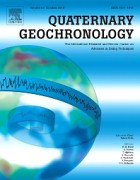|
Literature / Source Database:
Quaternary Geochronology
Description
the international research and review journal on advances in quaternary dating techniques
| Title (short) |
Quat. Geochronol. |
| Languages |
English |
| Impact factor |
3.962 |
|
|

|
Status
active
Indexing
GeoRef, EBSCOhost, Engineering Village - GEOBASE, Scopus, PubMed/Medline, ProQuest, Arts & Humanities Search, Current Contents, Science Citation Index Expanded, Web of Science, INSPEC
Subject

Source type
Journal
Publisher
ISBN ISSN
1871-1014
First volume
1
Last volume
58+
Publish city
Amsterdam
Homepage
| Resources |
|
Availability |
|
|
|
|
|
| Text PDF |
 |
free access |
 |
| Text Html |
 |
for subscriber |
 |
| References |
 |
not available |
 |
| Abstracts |
 |
|
|
| TOC |
 |
|
|
|
|
|
|

Description
Quaternary Geochronology is an international journal devoted to the publication of the highest-quality, peer-reviewed articles on all aspects of dating methods applicable to the Quaternary Period - the last 2.6 million years of Earth history. Reliable ages are fundamental to place changes in climates, landscapes, flora and fauna - including the evolution and ecological impact of humans - in their correct temporal sequence, and to understand the tempo and mode of geological and biological processes. Some Quaternary dating methods are well established, while others are in the early stages of development. Quaternary Geochronology provides a readily accessible platform to rapidly communicate the latest developments and applications in these emerging fields, as well as improvements made to more traditional methods of age determination. New technological capabilities are providing a greater understanding of the underlying principles of age estimation and are stimulating innovative applications. Quaternary Geochronology will publish research in the following areas:
• Principles of geochronological methods
• Advances in methodology, analytical procedures and instrumentation
• Methodological standardisations and inter-laboratory comparisons
• Calibrations and comparisons of different methods
• Novel and groundbreaking applications in all fields of Quaternary research
|